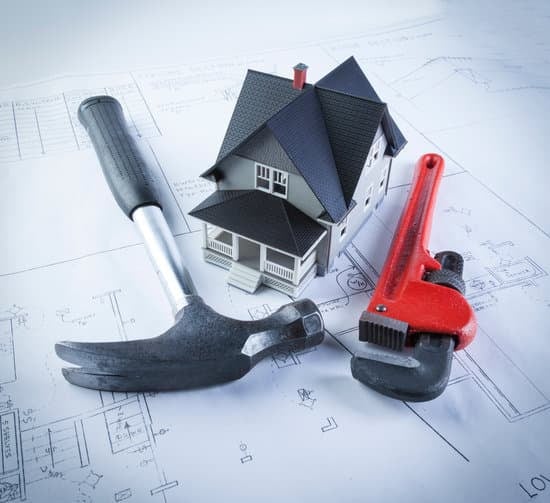When it comes to making improvements to your home, financing can be a major consideration. Many homeowners turn to home improvement loans to help fund these projects, but what about the interest paid on these loans? Can it be deducted on your taxes? This article explores the ins and outs of the home improvement loan interest deduction, providing you with valuable information to make informed financial decisions.
To begin, let’s delve into the concept of a home improvement loan and its purpose. These loans are specifically designed to finance renovation or remodeling projects for your primary residence.
Whether you’re looking to upgrade your kitchen, add a new bathroom, or convert your basement into livable space, a home improvement loan can provide the necessary funds. In this section, we will explore the different types of home improvement loans available and their benefits in relation to tax deductions.
Understanding the potential benefits of using a home improvement loan is crucial when considering financing options for your project. Using cash or credit cards may not only deplete your savings but also result in high-interest charges.
Home improvement loans offer various advantages such as fixed interest rates, longer repayment terms, and potentially lower overall costs compared to other financing methods. In this article, we will dive deeper into these benefits as well as highlight how utilizing a home improvement loan can lead to tax deductions.
What is a Home Improvement Loan? Exploring the concept and purpose behind these loans
A home improvement loan is a type of personal loan specifically designed to finance renovations or upgrades to a property. These loans are typically used to fund projects such as remodeling a kitchen, adding an additional room, or renovating a bathroom. The concept behind a home improvement loan is to provide homeowners with the necessary funds to make improvements that can increase the value of their property.
One of the main purposes of a home improvement loan is to help homeowners increase their property’s market value. By making significant upgrades or renovations, homeowners can potentially sell their house for a higher price in the future. Additionally, these loans can also improve the overall functionality and livability of the property, enhancing the homeowner’s quality of life.
There are various types of home improvement loans available in the market, including secured and unsecured options. Secured loans require collateral, such as your home or another valuable asset, while unsecured loans do not require any collateral. The interest rates on these loans can vary depending on factors such as credit score and loan amount. It is important to carefully consider your options and choose the loan that best fits your needs before committing to any financial agreements.
| Loan Type | Description | Interest Rate Range |
|---|---|---|
| Secured Loan | Requires collateral (e.g., home or asset) for approval. | 3% – 8% |
| Unsecured Loan | No collateral required. | 6% – 12% |
The Benefits of Using a Home Improvement Loan
A home improvement loan can offer numerous benefits to homeowners who are looking to finance their renovation projects. One of the major advantages of using a home improvement loan is that it allows homeowners to access a significant amount of funds upfront, enabling them to complete their projects without having to wait or compromise on the quality of materials and services used.
Furthermore, home improvement loans often come with lower interest rates compared to other types of loans, such as personal loans or credit cards. This can result in substantial cost savings over time, especially for large projects that require a significant amount of borrowing. Additionally, many home improvement loans offer fixed interest rates, providing borrowers with predictability and stability when it comes to their monthly payments.
Another benefit of financing home improvements through a loan is the potential increase in property value. By investing in renovations and upgrades, homeowners can potentially raise the market value of their properties. This can be particularly advantageous for those planning to sell their homes in the future or borrow against their equity.
In summary, utilizing a home improvement loan provides several advantages for homeowners embarking on renovation projects. From accessing lump sum funds upfront to enjoying lower interest rates and the possibility of increasing property value, these loans offer financial flexibility and tangible benefits that can make home improvements more accessible and rewarding.
Is the Interest Paid on a Home Improvement Loan Tax Deductible? Digging into the IRS regulations and guidelines
One of the most important questions homeowners have when considering a home improvement loan is whether or not the interest paid on the loan is tax deductible. The answer to this question lies in the regulations and guidelines set forth by the Internal Revenue Service (IRS).
According to the IRS, in order for the interest paid on a home improvement loan to be tax deductible, it must meet certain criteria. First and foremost, the loan must be secured by your main home or a second home. This means that loans secured by rental properties or investment properties do not qualify for the deduction.
Additionally, the loan proceeds must be used specifically for improvements made to your home. According to IRS guidelines, eligible improvements include any projects that add value to your home, prolong its useful life, or adapt it to new uses. Examples of eligible improvements may include remodeling a kitchen or bathroom, adding an addition to your home, or installing energy-efficient equipment.
It’s important to note that not all expenses related to home improvements qualify for a tax deduction. Generally, only the interest that is paid during the tax year can be deducted. Any principal payments towards the loan do not qualify as deductible expenses.
To claim the deduction for interest paid on a home improvement loan, you will need to itemize your deductions on Schedule A of your tax return. You will also need to provide documentation and records supporting your expenses, such as receipts and invoices from contractors or suppliers.
Overall, understanding the IRS regulations and guidelines surrounding deducting interest paid on a home improvement loan can help homeowners determine if they are eligible for this potential tax benefit.
| Criteria | Description |
|---|---|
| Loan Security | The loan must be secured by your main home or a second home. |
| Purpose of Loan | The loan proceeds must be used specifically for improvements made to your home. |
| Qualified Improvements | Improvements that add value to your home, prolong its useful life, or adapt it to new uses. |
| Expenses Eligible for Deduction | Generally, only the interest paid during the tax year can be deducted. Principal payments towards the loan do not qualify. |
| Claiming the Deduction | To claim the deduction, you will need to itemize your deductions on Schedule A of your tax return and provide supporting documentation and records. |
Eligibility Criteria for Deducting Interest on a Home Improvement Loan
When it comes to deducting interest paid on a home improvement loan, there are certain eligibility criteria that homeowners must meet in order to qualify for this tax benefit. Understanding these requirements is essential for maximizing the potential tax savings associated with financing your home improvements through a loan.
Primary Residence
To be eligible for deducting interest on a home improvement loan, the property in question must be your primary residence. The Internal Revenue Service (IRS) considers a primary residence as the place where you live most of the time. If you have more than one home, only the interest paid on loans for improvements made to your primary residence would be eligible for deduction.
It’s important to note that vacation homes or investment properties are not eligible for this tax benefit. However, if you have both an investment property and a primary residence and you take out a loan to make improvements on your primary residence, you may still be able to deduct the interest as long as the loan is secured by your main home.
Qualified Expenses
Another requirement for deducting interest on a home improvement loan is that the funds borrowed must have been used specifically for qualified expenses related to improving your home. Qualified expenses include costs directly associated with alterations, renovations, or additions that add value to your property. This can include activities such as remodeling a kitchen or bathroom, adding an extra bedroom, or installing energy-efficient features.
It’s important to keep accurate records of all expenses incurred in relation to the home improvement project. This includes invoices, receipts, and other documentation that can substantiate the amounts spent on qualified expenses.
Total Loan Limit
In addition to meeting the above-mentioned criteria, there is also a limit on the total amount of debt that qualifies for deductible interest. As of 2021, the limit is $750,000 for individuals or $1 million for married couples filing jointly. This includes the outstanding principal on any mortgage loans used to acquire, build, or substantially improve your primary residence.
If the total debt exceeds these limits, only a portion of the interest paid on the home improvement loan may be deductible. It’s important to consult with a tax professional or refer to IRS guidelines to determine the specific limitations that may apply in your situation.
By meeting these eligibility criteria, homeowners can take advantage of the potential tax benefits associated with deducting interest paid on a home improvement loan. Understanding and adhering to these requirements will help ensure that you can maximize your deductions and potentially save money when financing your home improvements through a loan.
How to Claim the Deduction
Gather Relevant Documentation
Before claiming the deduction for interest paid on a home improvement loan, it is important to gather all the necessary documentation. This includes any loan statements or documents provided by the lender that outline the interest paid throughout the year. It is recommended to keep these documents in a safe and easily accessible place along with other tax-related paperwork.
Complete Form 1040 Schedule A
To claim the deduction, taxpayers must itemize deductions on their tax return using Form 1040 Schedule A. This form allows individuals to report various deductible expenses, including mortgage interest and home improvement loan interest.
On Schedule A, there is a section specifically designated for reporting home mortgage interest and points. Taxpayers should enter the total amount of interest paid on their home improvement loan in this section. It is important to ensure accurate reporting of this amount as any errors could potentially trigger an IRS audit.
Keep Records for Verification
As with any tax deduction, it is crucial to maintain accurate records and supporting documentation for verification purposes. In case of an IRS audit or review, taxpayers should be able to provide evidence of the interest paid on their home improvement loan.
It is advisable to keep copies of loan statements, receipts, canceled checks, or any other relevant documents that substantiate the claimed deductible amount. These records should be kept for at least three years from the date of filing the tax return.
By following these steps and maintaining proper documentation, homeowners can successfully claim the deduction for interest paid on their home improvement loans and potentially reduce their overall taxable income. It is always recommended to consult with a tax professional or refer directly to IRS guidelines when navigating deductions and filing taxes.
Potential Limitations and Restrictions
Income Limitations
The IRS has imposed income limitations for taxpayers who wish to deduct the interest paid on a home improvement loan. As of the 2021 tax year, if you’re filing as an individual, your modified adjusted gross income (MAGI) must be below $100,000 to qualify for the deduction. For joint filers, the threshold is $200,000. If your income exceeds these limits, you won’t be eligible for the deduction.
Use of Loan Proceeds
It’s important to note that in order to deduct the interest paid on a home improvement loan, the funds obtained from the loan must have been used solely for home improvement purposes. This means that any portion of the loan that was used for personal expenses or other non-home related purposes will not qualify for the deduction.
To ensure compliance and avoid any potential issues with IRS audits, it is advisable to keep detailed records and documentation regarding how the loan proceeds were utilized.
Tax Benefit Limits
While deducting interest on a home improvement loan can provide tax benefits, it’s essential to understand that there are limits to how much interest you can deduct. The IRS specifies that you can only deduct interest on loans up to $750,000 ($375,000 if married filing separately) if they are used to improve your main home or second home. Additionally, this limitation applies collectively to all mortgages secured by your main home and second home.
These limitations and restrictions highlight the importance of carefully considering whether claiming a deduction for interest paid on a home improvement loan is feasible in your specific situation. Consulting with a tax professional or utilizing tax software can help ensure accuracy and compliance with IRS regulations while maximizing potential deductions.
Supporting Documents and Record-Keeping
Maintaining accurate records and supporting documents is crucial when it comes to substantiating the interest deduction on a home improvement loan. This section will discuss the importance of record-keeping and highlight the types of documents homeowners should keep for tax purposes.
Record-keeping is essential because it helps homeowners provide evidence to support their claims when deducting the interest paid on a home improvement loan. It is recommended to create a dedicated folder or file where all relevant documents can be stored throughout the year. Here are some key documents that should be included:
- Loan Documents: Homeowners must retain copies of their loan agreement, including the terms, conditions, and provisions related to interest payments. This document will serve as proof of the loan amount, its purpose (home improvement), and the specific terms regarding interest.
- Receipts and Invoices: Homeowners should keep track of all receipts and invoices related to their home improvement projects. This includes bills from contractors, materials purchased, rental equipment fees, and any other expenses incurred during the renovation process. These receipts will help substantiate the eligible expenses claimed for deduction.
- Proof of Payment: It’s important to keep records of payments made towards the loan and any associated fees. Retain copies of canceled checks, bank statements showing electronic transfers or debit card transactions, or any other relevant payment documentation.
- Property Records: Homeowners should also maintain records regarding the ownership and value of their property before and after improvements were made. This could include appraisal reports, real estate assessments, or any other documentation that supports an increase in property value due to renovations.
- Any Other Supporting Documentation: In addition to the above-mentioned documents, it’s advisable to keep any other relevant paperwork that can further document your eligibility for claiming deductions on home improvement loan interest. This may include permits obtained for construction work done, contractor agreements, architectural plans or drawings if applicable.
By keeping these records organized and readily available, homeowners can ensure that they have the necessary documentation to support their deduction claims when filing their tax returns. It’s important to note that the IRS may require homeowners to provide these documents as proof of qualifying expenses, so maintaining accurate records is crucial throughout the process.
Frequently Asked Questions
Homeowners who are considering deducting the interest paid on a home improvement loan may have a number of questions and concerns. In this section, we will address some of the most frequently asked questions pertaining to this topic.
- Can I deduct the interest paid on any type of home improvement loan?
- Are there any limits on the amount of interest that can be deducted?
- Can I claim the deduction if I use a personal loan or credit card for my home improvement project?
The IRS allows homeowners to deduct interest paid on loans used for substantial improvements to their primary residence or a second home. However, it is important to note that not all types of home improvement loans qualify for this deduction. Typically, only loans that are secured by the property, such as a home equity loan or line of credit, will be eligible.
Yes, there are limits on how much interest you can deduct. As of 2021, if you meet the eligibility criteria, you can generally deduct the interest paid on up to $750,000 in qualified residence loans ($375,000 for married filing separately). It is also important to keep in mind that these limits apply to the combined total of your mortgage debt and home improvement loan debt.
No, unfortunately personal loans and credit cards do not typically qualify for the home improvement loan interest deduction. To be eligible for the deduction, the loan must be secured by your primary residence or second home.
Overall, it is crucial to consult with a tax professional or refer to IRS guidelines for specific information regarding eligibility and limitations when claiming deductions on your tax return.
Final Thoughts
To ensure that you qualify for this deduction, it is important to meet the eligibility criteria set by the IRS. Additionally, maintaining accurate records and supporting documents is crucial in substantiating your claim. By keeping track of relevant documentation such as loan statements and receipts, you can confidently include the interest deduction on your tax return.
It is worth noting that while deducting interest paid on a home improvement loan can provide financial benefits, there may be limitations and restrictions. These could include specific requirements related to the purpose of the loan or potential caps on the amount that can be deducted. Therefore, it is advisable to consult with a tax professional or review IRS guidelines when claiming this deduction.
In addition to exploring the potential tax benefits of deducting interest paid on a home improvement loan, homeowners should also consider other alternative tax deductions related to their renovation projects. For example, certain energy-efficient upgrades may qualify for separate tax credits or deductions. By researching these options and consulting with professionals, homeowners can maximize their overall savings during and after their home improvement projects.
Overall, taking advantage of available deductions can help make financing your home improvements more affordable. As with any financial decision, it’s important to weigh the pros and cons based on your individual circumstances. By doing so, you can make informed decisions about financing your renovations while potentially benefiting from valuable tax deductions along the way.
Alternative Tax Deductions for Home Improvements
While deducting the interest paid on a home improvement loan can provide significant tax benefits, it’s important to note that there may be additional deductions available to homeowners who have undertaken home improvement projects. These alternative tax deductions can further reduce the overall tax liability and should not be overlooked when considering the financial implications of renovating or upgrading your home.
One common deduction is the energy-efficient home improvement credit. This credit allows homeowners to claim a percentage of the cost of certain energy-efficient upgrades such as solar panels, energy-efficient windows, or insulation. By taking advantage of this credit, not only can you save on your energy bills in the long run, but you may also be eligible for a substantial tax credit.
Another potential deduction is the medical expense deduction for home modifications. If you have undertaken home improvements specifically for medical reasons, such as adding wheelchair ramps or modifying bathroom facilities for disabled individuals, you may be able to include these costs as part of your medical expenses when filing your taxes. It’s important to consult with a tax professional to determine if your specific circumstances qualify for this deduction.
Additionally, if you use a portion of your home exclusively for business purposes, you may be able to deduct some of the costs associated with those improvements. For example, if you have converted a room in your house into a dedicated home office space or studio for your business, you may be eligible to deduct a portion of the expenses associated with that renovation.
In conclusion, while deducting interest paid on a home improvement loan can provide valuable tax benefits, it is worth exploring other potential deductions related to home improvement projects. The energy-efficient home improvement credit and medical expense deduction for home modifications are just two examples of alternative deductions that could further reduce your overall tax liability.
By carefully considering all available options and consulting with a tax professional, homeowners can optimize their savings and make the most of their home improvement investments.
Frequently Asked Questions
Do you get a 1098 for a home improvement loan?
No, you do not receive a 1098 for a home improvement loan. A 1098 form is used to report payments and interest received on mortgages, specifically those secured by real property. Home improvement loans, on the other hand, are typically unsecured personal loans that are not tied to your home’s value or mortgage.
Can you claim interest on a construction loan for taxes?
Yes, you can claim interest on a construction loan for taxes under certain circumstances. When the construction loan is used to build or substantially improve your primary residence or second home, the interest paid on that loan may be tax-deductible.
However, it is important to note that there are certain limitations and requirements set by the IRS in order for this deduction to apply.
How long is the interest on a construction loan tax-deductible?
The interest on a construction loan is generally deductible during the period of construction itself and for a limited time after. Specifically, the IRS allows deductibility of interest payments during the time when the home is being constructed and up until it becomes “substantially complete.”
This typically includes both the building phase and any post-construction periods where additional work such as landscaping or interior finishing takes place. Once the property reaches substantial completion, typically defined as reaching an occupancy permit or certificate of completion, the interest deduction may no longer be available unless the property qualifies as your primary residence or second home.

I’m thrilled to have you here as a part of the Remodeling Top community. This is where my journey as an architect and remodeling enthusiast intersects with your passion for transforming houses into dream homes.





